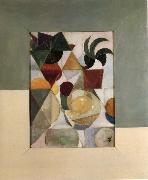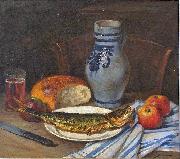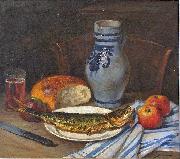
|
Theo van Doesburg
|
|||
|
|
|||
| Dutch 1883-1931 Dutch painter, architect, designer and writer. He was officially registered as the son of Wilhelm Kepper and Henrietta Catharina Margadant, but he was so convinced that his mother second husband, Theodorus Doesburg, was his father that he took his name. Little is known of his early life, but he began painting naturalistic subjects c. 1899. In 1903 he began his military service, and around the same time he met his first wife, Agnita Feis, a Theosophist and poet. Between about 1908 and 1910, much influenced by the work of Honor Daumier, he produced caricatures, some of which were later published in his first book De maskers af! (1916). Also during this period he painted some Impressionist-inspired landscapes and portraits in the manner of George Hendrik Breitner. Between 1914 and 1915 the influence of Kandinsky became clear in such drawings as Streetmusic I and Streetmusic II (The Hague, Rijksdienst Beeld. Kst) and other abstract works. | |||
|
|
|||
|
Nature Morte new16/Theo van Doesburg-427654.jpg Painting ID:: 45003 |
mk183 Oil on canvas 82x67.5cm | ||
|
|
|||
|
Fernard Leger
|
|||
|
|
|||
| France.1881-1955 | |||
|
|
|||
| This artist (Fernard Leger) is not available now. | |||
|
|
|||
|
Fernand Leger
|
|||
|
|
|||
| French Cubist Painter, 1881-1955,was a French painter, sculptor, and filmmaker,Leger was born in the Argentan, Orne, Basse-Normandie, where his father raised cattle. Fernand Leger initially trained as an architect from 1897-1899 before moving in 1900 to Paris, where he supported himself as an architectural draftsman. After military service in Versailles in 1902-1903, he enrolled at the School of Decorative Arts; he also applied to the Ecole des Beaux-Arts but was rejected. He nevertheless attended the Beaux-Arts as a non-enrolled student, spending what he described as "three empty and useless years" studying with Gerome and others, while also studying at the Academie Julian. He began to work seriously as a painter only at the age of 25. At this point his work showed the influence of Impressionism, as seen in Le Jardin de ma mere (My Mother's Garden) of 1905, one of the few paintings from this period that he did not later destroy. A new emphasis on drawing and geometry appeared in Leger's work after he saw the Cezanne retrospective at the Salon d'Automne in 1907. In 1909 he moved to Montparnasse and met such leaders of the avant-garde as Archipenko, Lipchitz, Chagall, and Robert Delaunay. His major painting of this period is Nudes in the Forest (1909-10), in which Leger displayed a personal form of Cubism??his critics called it "Tubism" for its emphasis on cylindrical formsethat made no use of the collage technique pioneered by Braque and Picasso. In 1910 he joined with several other artists, including Delaunay, Jacques Villon, Henri Le Fauconnier, Albert Gleizes, Francis Picabia, and Marie Laurencin to form an offshoot of the Cubist movement, the Puteaux Group??also called the Section d'Or (The Golden Section). Leger was influenced during this time by Italian Futurism, and his paintings, from then until 1914, became increasingly abstract. Their vocabulary of tubular, conical, and cubed forms are laconically rendered in rough patches of primary colours plus green, black and white, as seen in the series of paintings with the title Contrasting Forms. Leger's experiences in World War I had a significant effect on his work. Mobilized in August 1914 for service in the French Army, he spent two years at the front in Argonne. He produced many sketches of artillery pieces, airplanes, and fellow soldiers while in the trenches, and painted Soldier with a Pipe (1916) while on furlough. In September 1916 he almost died after a mustard gas attack by the German troops at Verdun. | |||
|
|
|||
| This artist (Fernand Leger) is not available now. | |||
|
|
|||
|
unknow artist
|
|||
|
|
|||
|
|
|||
|
Nature morte new24/unknow artist-638754.jpg Painting ID:: 74227 |
"Nature morte" , oil painting on canvas (50 x 60 cm) by Willem Battaille (1867-1933); private collection cjr | ||
|
|
|||
|
Georges Jansoone
|
|||
|
|
|||
| George Jamesone (or Jameson) (c. 1587-1644) was Scotland's first eminent portrait-painter. He was born in Aberdeen, where his father, Andrew Jamesone, was a stonemason. Jamesone attended the grammar school near his home on Schoolhill and is thought to have gone on to further education at Marischal College. Legend has it that Jamesone once studied under Rubens in Antwerp with Anthony van Dyck. However, this is yet to be proven as his name does not appear to be noted in the Guild registers of the town. However, considering that Rubens was exempt from registering pupils; this does not mean that the painter definitely did not study there. Jamesone certainly did complete an apprenticeship under the supervision of his uncle, John Anderson, who was a popular decorative painter in Edinburgh at the beginning of the seventeenth century. Jamesone finished this training in 1618. He is not recorded as being in Aberdeen again until 1620. If the Scotsman had gone to Antwerp, it would have had to have been between the years of 1618 to 1620. | |||
|
|
|||
|
Nature morte new24/Georges Jansoone-565387.jpg Painting ID:: 75642 |
Nature morte" , oil painting on canvas (50 x 60 cm) by Willem Battaille (1867-1933); private collection cyf | ||
|
|
|||
|
Also Buy::. For Following Paintings / Artists / Products, Please Use Our Search Online: |










